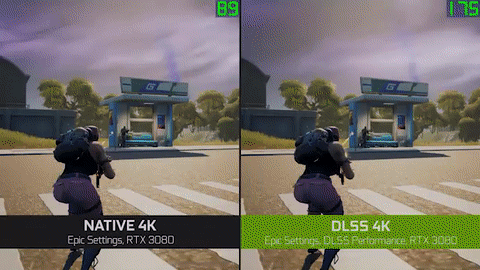NVIDIA DLSS

NVIDIA DLSS (Deep Learning Super Sampling) is a neural graphics technology that multiplies performance using AI to create entirely new frames, display higher resolution through image reconstruction, and improve the image quality of intensive ray-traced content—all while delivering best-in-class image quality and responsiveness.
Explore the Benefits of DLSS
Performance Multiplier
The AI network analyzes sequential frames and motion data to create additional high-quality, responsive frames.
AI that Improves
DLSS takes advantage of AI models that are continuously improved through ongoing training on NVIDIA supercomputers, providing better image quality and performance across more games and applications.
Enhanced Ray Tracing
An NVIDIA supercomputer-trained network replaces hand-tuned denoisers to generate higher quality pixels in between sampled rays.
DLSS Ray Reconstruction
DLSS Ray Reconstruction is a neural rendering technique for all GeForce RTX GPUs that improves the image quality of intensive ray-traced content. DLSS Ray Reconstruction replaces hand-tuned denoisers with an NVIDIA Supercomputer-trained AI network that generates higher quality pixels in between sampled rays.
DLSS Frame Generation
Boosts performance by using AI to generate more frames. DLSS Frame Generation analyzes sequential frames and motion data from the new Optical Flow Accelerator in GeForce RTX 40 Series GPUs to create additional high-quality frames.
See DLSS in Action in Top Titles
Cyberpunk 2077
Portal with RTX
Microsoft Flight Simulator
Check Out DLSS-Supported Game Engines

Unreal Engine
DLSS is available in Unreal Engine (UE) through our official DLSS UE plugin. UE developers can benefit from the boosted frame rates and beautiful, sharp images that DLSS creates.
Get StartedUnity
DLSS Super Resolution is natively supported for the High-Definition Render Pipeline (HDRP) in Unity 2021.2 and higher. Unity developers can benefit from the performance headroom to maximize ray tracing settings, boost frame rates, and increase output resolution, resulting in beautiful, sharp images that DLSS creates.
Download UnityTest Experimental Models for DLSS Research
NVIDIA is enabling developers to explore and evaluate experimental AI models for DLSS. Developers can download experimental dynamic-link libraries (DLLs), test how the latest DLSS research enhances their games, and provide feedback for future improvements.
Download the latest DLLs

Stay Up to Date on NVIDIA DLSS News
View all industry news
NVIDIA DLSS Sessions On-Demand
Discover More Resources
Get Answers to Frequently Asked Questions
A: NVIDIA DLSS (Deep Learning Super Sampling) is a neural graphics technology that multiplies performance using AI to create entirely new frames, display higher resolution through image reconstruction, and improve the image quality of intensive ray-traced content — all while delivering best-in-class image quality and responsiveness.
A: DLSS is powered by NVIDIA RTX Tensor Cores. By tapping into a deep learning neural network, DLSS is able to combine anti-aliasing, feature enhancement, image sharpening, and display scaling, which traditional anti-aliasing solutions cannot. With this approach, DLSS can multiply performance with comparable image quality to full-resolution native rendering.
A: Ray Reconstruction is coming soon to all game developers - sign up to be notified here. Dynamic Frame Generation and Auto Scene Change Detection are available in DLSS 3.5 through Streamline Plugin 2.2+.
A: You can access the binary Unreal Engine DLSS plug-in here. You can also get source code via GitHub. Follow the instructions on the UE/GitHub page to link your Epic Games and GitHub accounts to gain access. The plug-in is compatible with UE5 and UE4.26.
A: DLSS super resolution is available for all NVIDIA RTX GPUs. DLSS 3 with Optical Multi Frame Generation is available for GeForce RTX 40 Series GPUs.
A: Yes, NVIDIA Image Scaling (SDK) is an open-source, best-in-class, spatial upscaler and sharpening algorithm that works cross-platform on all GPUs. NVIDIA Image Scaling SDK is a great compliment to NVIDIA DLSS for developers looking for a solution to support non-RTX GPUs. Learn more here.




